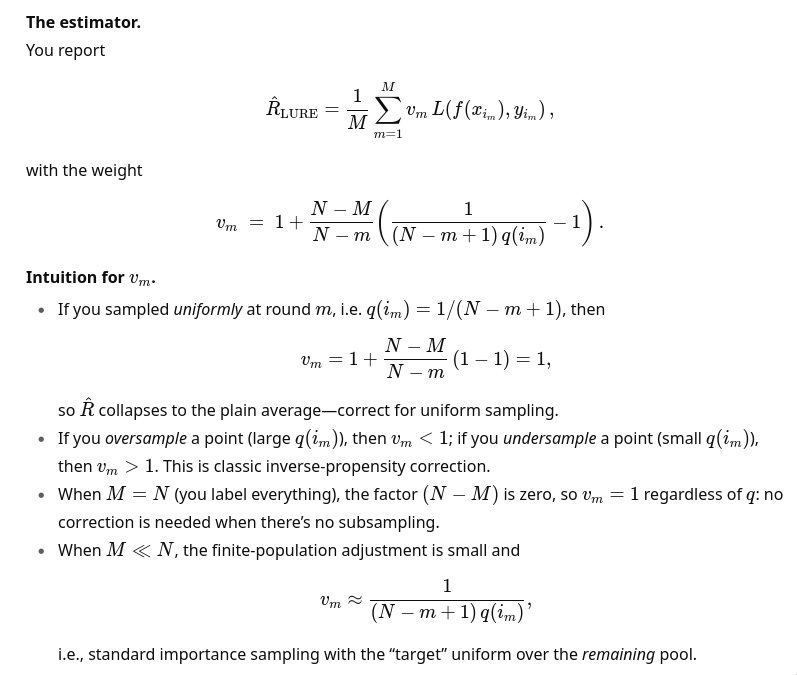Active training and active testing in ML
- [2103.05331] Active Testing: Sample-Efficient Model Evaluation
- <_(@kossenactivetesting2021) “Active Testing: Sample-Efficient Model Evaluation” (2021) / Jannik Kossen, Sebastian Farquhar, Yarin Gal, Tom Rainforth: z / http://arxiv.org/abs/2103.05331 /
10.48550/arXiv.2103.05331_>1 - Introduces active testing
- <_(@kossenactivetesting2021) “Active Testing: Sample-Efficient Model Evaluation” (2021) / Jannik Kossen, Sebastian Farquhar, Yarin Gal, Tom Rainforth: z / http://arxiv.org/abs/2103.05331 /
- [2101.11665] On Statistical Bias In Active Learning: How and When To Fix It the paper describing the estimator for AL in detail, the one that removes bias when sampling
- [2508.09093] Scaling Up Active Testing to Large Language Models
- <_(@berradascalingactive2025) “Scaling Up Active Testing to Large Language Models” (2025) / Gabrielle Berrada, Jannik Kossen, Muhammed Razzak, Freddie Bickford Smith, Yarin Gal, Tom Rainforth: z / http://arxiv.org/abs/2508.09093 /
10.48550/arXiv.2508.09093_> 2 - adapts it to LLMs to LLMs
- <_(@berradascalingactive2025) “Scaling Up Active Testing to Large Language Models” (2025) / Gabrielle Berrada, Jannik Kossen, Muhammed Razzak, Freddie Bickford Smith, Yarin Gal, Tom Rainforth: z / http://arxiv.org/abs/2508.09093 /
OK, so.
Active testing1
-
Active learning: picking the most useful training instances to the model (e.g. because annotation is expensive, and we pick what to annotate)
-
Active testing: pick the most useful subset of testing instances that approximates the score of the model on the full testing set.
-
We can test(=I use label below) only a subset of the full test set, $D_{test}^{observed}$ from $D_{test}$
-
We decide to label only a subset $N>M$ of the test instances, and not all together, but one at a time, because then we can use the information of the already labeled test instances to pick which next one to label
-
It calls these (estimated or not) test scores test risk, $R$ .
Strategies
- Naive: we uniformly sample the full test dataset
- BUT if $M«N$, its variance will be large, so though it’s uniformly/unbiasedly sampled, it won’t necessarily approximate the real score well
- Actively sampling, to reduce the variance of the estimator.
- Actively selecting introduces biases as well if not done right
- e.g. active learning you label hard points to make it informative, but in active testing testing on hard points will inflate the risk
- Actively selecting introduces biases as well if not done right
Active sampling
- sth monte carlo etc. etc.
- TODO grok the math and stats behind all of this.
- follows my understanding that might be wrong
- The [2101.11665] On Statistical Bias In Active Learning: How and When To Fix It paper that introduces $R_{lure}$ is might be a starting point but at first sight it’s math-heavy
- TL;DR pick the most useful points, and get rid of the biases this introduces (e.g. what if they are all complex?) by using smart auto-correcting mechanisms (=‘unbiased estimator’)
- You have some $q(i_m)$ strategy that picks interesting samples, though they might bias the result.
- $q(i_m)$ is actually shorthand for $q(i_m, i_{1:m-1}, D_{test}, D_{train})$ — so we have access to the the datasets and the already aquired test data.
- $R_{LURE}$: An unbiased estimator that auto-corrects the discribution to be closer to the one expected if you iid-uniformly sample the test dataset.
- ChatGPT on the intuition behind this:

- also:
This is the classic promise of importance sampling: move probability mass toward where the integrand is large/volatile, then down-weight appropriately.
- also:
Bottom line: active testing = (i) pick informative test points stochastically with $q$; (ii) compute a weighted Monte Carlo estimate with $v_m$ to remove selection bias; (iii) enjoy lower variance if $q$ is well-chosen.
-
<_(@kossenactivetesting2021) “Active Testing: Sample-Efficient Model Evaluation” (2021) / Jannik Kossen, Sebastian Farquhar, Yarin Gal, Tom Rainforth: z / http://arxiv.org/abs/2103.05331 /
10.48550/arXiv.2103.05331_> ↩︎ ↩︎ -
<_(@berradascalingactive2025) “Scaling Up Active Testing to Large Language Models” (2025) / Gabrielle Berrada, Jannik Kossen, Muhammed Razzak, Freddie Bickford Smith, Yarin Gal, Tom Rainforth: z / http://arxiv.org/abs/2508.09093 /
10.48550/arXiv.2508.09093_> ↩︎